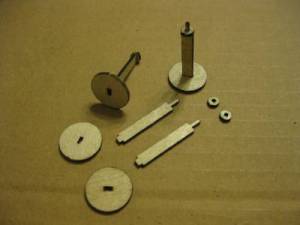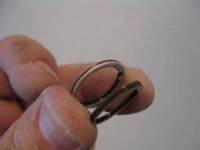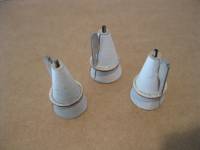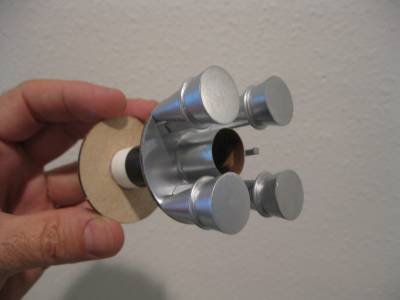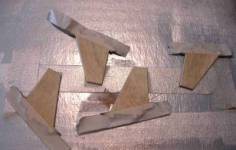Saturn Press Saturn V
By Hans "Chris" Michielssen
2011-04-11
| Manufacturer: | Saturn Press | |
| Diameter: | 2.0420 inches | |
| Skill Level: | 3 | |
| Style: | Scale |
Designed by Peter Alway, the Saturn Press Saturn V is a 1/195th scale model of the rocket which carried men to the moon.
Opening the Bag
2011-04-11
I received my Saturn V kit from Jonrocket.com. I'd had my eye on this kit for a while.
The instructions look to be comprehensive, covering 22 pages. I didn't see a parts list.

My first thought upon opening the bag was that there are a lot of laser burned parts! Most are burned in 1/16" plywood. The RCS thrusters and tower support pieces are cut in 1/32" plywood. The liquid hydrogen lines are cut into 1/16" basswood.

The body tubes are laser marked for all the trim pieces. Faint burnt lines give you all locations for the trim pieces. There'll be no measuring or guessing the trim locations on this build! Other laser lines are cut through the body tube to allow assembly tabs to be glued.

There are an extra fin fairing shroud and an extra nozzle shroud - a nice touch! You are also given extras of the escape motor shrouds. The escape motor shrouds are tiny. I'm a big fan of providing extra shrouds in a kit.
Seven pennies are included, one has a center hole drilled to tie on a Kevlar line. A black adhesive vinyl roll pattern is pre cut for the S-II/S-IVB adapter.

I'd read over the instructions last night and started construction today.
There are many laser burned parts. I wanted to seal them before removing them from the cut sheets. I applied two coats of varnish to all the flat surfaces. After sanding smooth, this will give me a smooth surface that won't absorb too much paint later.
Steps 1 - 5
2011-04-11
The Engine Mount Assembly is first up. There is nothing really unusual here, a BT-20 Engine Mount Tube, Standard Engine Hook, two Centering Rings and an Engine Block. The rear Centering Ring has eight rectangular holes for the Nozzle Assembly mounts.

Step 6
2011-04-11
Three plywood pieces make up the Nozzle inside frames. These parts are an example of great laser cutting. The pieces fit together very well.

Step 7
2011-04-11
Before cutting out the Nozzle Shrouds, I scanned them for backups if needed. The Nozzle Cardstock Sheet is printed on thinner stock than I would normally use for shrouds. It feels like 65 lb. paper.
The Nozzles were cut out and formed in the palm of my hand using progressively smaller dowels. All four were glued together with White Glue and left to dry.

Step 8
2011-04-12
The Nozzle Shrouds were test fitted over the Nozzle Framework. All were consistent, the lower plywood circle was extended ½ way out the back of the Nozzle in all four assemblies.
The lower disks were sanded at an angle to end up flush with the bottom of the Nozzle cone. It took very little sanding for the Assemblies to fit well into the Nozzles.
The Nozzles were glued over the Nozzle Framework being sure to line up the Shroud Seam with the lower tab.

With the Nozzle Framework in the Shrouds, the formed Nozzle cardstock is very strong. I filled the Shroud Seam and lower Framework Disk with Carpenter's Wood Filler.
Step 9
2011-04-12
The Nozzle Ring take a few cuts with a sharp knife to remove it from the Laser Cut Sheet. Take you time, it is thin on the narrow side and can crack.

The instructions say: "You many also wish to sand the outer edges round." I rounded the outside edges and sprayed everything with grey primer before gluing the pieces together. It would be very hard to fill and seal the plywood pieces after the Nozzle Assemblies are in place.
The center of the Nozzle Rings needed very little sanding to fit perfectly over the Nozzles and rest between the dashed lines.
Step 10
2011-04-12
 The four Turbine Exhaust Lines were removed from the Laser Cut Sheet. These pipelines are more of a flat "profile" look and not a rounded shape. They do add significant support to the Nozzle Assemblies when glued in place.
The four Turbine Exhaust Lines were removed from the Laser Cut Sheet. These pipelines are more of a flat "profile" look and not a rounded shape. They do add significant support to the Nozzle Assemblies when glued in place.
Before gluing onto the bottom of the Rear Adapter Ring, I sprayed them separately with a White spray undercoat. I'll follow with Silver then glue them in place.
Earlier I decided to paint the Rear Centering Ring and Nozzle Assemblies separately. I knew it'd be tough to get paint on all inside surfaces if it were glued before spraying.
I used the cheap WalMart Aluminum paint. It's very close to the recommended silver color and covers very well.
The Plywood Nozzle Rings did require some sanding between coats. I wanted them smooth, most of the Nozzle Assemblies will be visible behind the Fairing Shrouds.

Steps 11 - 14
2011-04-12
The Nozzles were glued in place. I had to scrape off some of the paint off the tabs so they would fit into the rear Adapter Ring holes.

Step 15 Fill And Seal fins
2011-09-24
The Fins are removed from the 1/16" plywood sheet. The outside edges are rounded with sandpaper and filled with Carpenter’s Wood Filler.
I followed with Grey Primer and sanded. The tight plywood grain still showed. I masked and applied the Aluminum paint on the shaded area shown in Step 15. continued with Aluminum spray paint, sanding between coats to fill the grain.
I’ve decided to paint the Fins and Fin Shrouds separately. While the instructions give great painting directions, masking the Black, White and Silver separations would be very hard to do after gluing everything together.

Step 16
2012-09-22
The A Frames and Fins were pressed together. The C Frames are pressed into the A Frames and Fins. Be careful handling the Fin paint while assembling. Silver or metallic paints are easy to dull with fingerprints.
After all were assembled dry (no glue) I applied white glue to all the joints with a toothpick.
Step 17
2012-09-22
The outside curved lines of the Engine Fairing Shrouds were cut from the cardstock with scissors. The interior Fin Slots were cut with a knife and straight-edge.
Sponsored Ads
 |
 |


